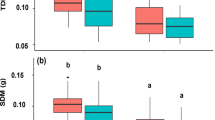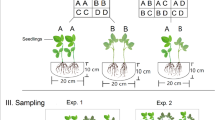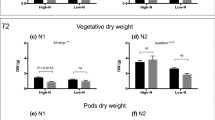Abstract
Aims
Kin selection and resource partitioning have been proposed to explain interactions between plants growing with siblings (from the same mother). These mechanisms have been examined by measurements of fitness, phenotype or allocation traits, but have seldom been tested with N acquisition traits.
Methods
We determine if kin selection and resource partitioning are occurring using two annual species (Sorghum vulgare and Glycine max) with a short-term 15N experiment. A mixture of ammonium, nitrate and glycine (1:1:1) was injected into soils around plants after they grew for 47 days. Only one nitrogen (N) form was 15N labeled in each labeling solution.
Results
S. vulgare increased root allocation when growing with strangers (from the different mother), but not increase their N uptake. Although G. max strangers did not increase their root allocation, they significantly increased uptake of total N and the most abundant N form (nitrate) and decreased uptake of the least abundant (glycine).
Conclusions
G. max siblings reduced competition due to chemical resource partitioning while S. vulgare showed kin selection. We concluded that processes related to kin selection and resource partitioning can occur simultaneously, resulting in different competitive ability. These findings can improve our understanding of plants growing with siblings or strangers.





Similar content being viewed by others
References
Andalo C, Goldringer I, Godelle B (2001) Inter- and intragenotypic competition under elevated carbon dioxide in Arabidopsis thaliana. Ecology 82:157–164
Bever JD, Dickie IA, Facelli E, Facelli JM, Klironomos J, Moora M, Zobel M (2010) Rooting theories of plant community ecology in microbial interactions. Trends Ecol Evol 25(8):468–478
Bhatt MV, Khandelwal A, Dudley SA (2011) Kin recognition, not competitive interactions, predicts root allocation in young Cakile edentula seedling pairs. New Phytol 189(4):1135–1142
Biedrzycki ML, Bais HP (2010) Kin recognition in plants: a mysterious behaviour unsolved. J Exp Bot 61:4123–4128
Biedrzycki ML, Jilany TA, Dudley SA, Bais HP (2010) Root exudates mediate kin recognition in plants. Commun Integr Biol 3(1):28–35
Biernaskie JM (2011) Evidence for competition and cooperation among climbing plants. Proc R Soc B Biol Sci 278:1989–1996
Cahill JF, McNickle GG, Haag JJ, Lamb EG, Nyanumba SM, Clair CCS (2010) Plants integrate information about nutrients and neighbors. Science 328:1657–1657
Chen BJ, During HJ, Anten NP (2012) Detect thy neighbor: identity recognition at the root level in plants. Plant Sci 195:157–167
Cheplick GP (1992) Sibling competition in plants. J Ecol 80(3):567–575
Cheplick GP, Kane KH (2004) Genetic relatedness and competition in Triplasis purpurea (Poaceae): resource partitioning or kin selection? Int J Plant Sci 165:623–630
Chu CJ, Maestre FT, Xiao S, Weiner J, Wang YS, Duan ZH, Wang G (2008) Balance between facilitation and resource competition determines biomass–density relationships in plant populations. Ecol Lett 11:1189–1197
Dudley SA, File AL (2007) Kin recognition in an annual plant. Biol Lett 3:435–438
Dudley SA, File AL (2008) Yes, kin recognition in plants! Biol Lett 4:69–70
File AL, Murphy GP, Dudley SA (2011) Fitness consequences of plants growing with siblings: reconciling kin selection, niche partitioning and competitive ability. Proc R Soc B Biol Sci 279(1727):209–218
Gao JQ, Mo Y, Xu XL, Zhang XW, Yu FH (2014) Spatiotemporal variations affect uptake of inorganic and organic nitrogen by dominant plant species in an alpine wetland. Plant Soil 381:271–278
Hamilton WD (1964) The genetical evolution of social behaviour. I. J Theor Biol 7:1–16
Kalembasa SJ, Jenkinson DSA (1973) Comparative study of titrimetric and gravimetric methods for determination of organic carbon in soil. J Sci Food Agric 24:1085–1090
Klemens JA (2008) Kin recognition in plants? Biol Lett 4(1):67–68
LeBauer DS, Treseder KK (2008) Nitrogen limitation of net primary productivity in terrestrial ecosystems is globally distributed. Ecology 89:371–379
Masclaux F, Hammond RL, Meunier J, Gouhier-Darimont C, Keller L, Reymond P (2010) Competitive ability not kinship affects growth of Arabidopsis thaliana accessions. New Phytol 185(1):322–331
McKane RB, Johnson LC, Shaver GR, Nadelhoffer KJ, Rastetter EB, Fry B, Giblin AE, Kielland K, Kwiatkowski BL, Laundre JA (2002) Resource-based niches provide a basis for plant species diversity and dominance in arctic tundra. Nature 415:68–71
Milla R, Forero DM, Escudero A, Iriondo JM (2009) Growing with siblings: a common ground for cooperation or for fiercer competition among plants? Proc R Soc B Biol Sci 276:2531–2540
Morgan JB, Connolly EL (2013) Plant-soil interactions: nutrient uptake. Nat Educ Knowl 4(8):2
Murphy GP, Dudley SA (2009) Kin recognition: competition and cooperation in Impatiens (Balsaminaceae). Am J Bot 96:1990–1996
Näsholm T, Sandberg G, Ericsson A (1987) Quantitative-analysis of amino-acids in conifer tissues by high-performance liquid-chromatography and fluorescence detection of their 9-fluorenylmethyl chloroformate derivatives. J Chromatogr 396:225–236
Reynolds HL, Packer A, Bever JD, Clay K (2003) Grassroots ecology: plant-microbe-soil interactions as drivers of plant community structure and dynamics. Ecology 84(9):2281–2291
Simonsen AK, Chow T, Stinchcombe JR (2014) Reduced plant competition among kin can be explained by Jensen’s inequality. Ecol Evol 4(23):4454–4466
Vitousek PM, Howarth RW (1991) Nitrogen limitation on land and in the sea: how can it occur? Biogeochemistry 13:87–115
Xu XL, Ouyang H, Cao GM, Richter A, Wanek W, Kuzyakov Y (2011) Dominant plant species shift their nitrogen uptake patterns in response to nutrient enrichment caused by a fungal fairy in an alpine meadow. Plant Soil 341:495–504
Zhang JB, Cai ZC, Zhu TB, Yang WY, Müller C (2013) Mechanisms for the retention of inorganic N in acidic forest soils of southern China. Sci Rep 3: doi 10.1038/srep02342
Acknowledgments
We thank Douglas Schaefer and Sina Adl for language improvements. This study was supported by Natural Science Foundation of China (31470560).
Author information
Authors and Affiliations
Corresponding author
Additional information
Responsible Editor: Jeffrey Walck.
Qianyuan Liu contributed equally to this work.
Rights and permissions
About this article
Cite this article
Zhang, L., Liu, Q., Tian, Y. et al. Kin selection or resource partitioning for growing with siblings: implications from measurements of nitrogen uptake. Plant Soil 398, 79–86 (2016). https://doi.org/10.1007/s11104-015-2641-z
Received:
Accepted:
Published:
Issue Date:
DOI: https://doi.org/10.1007/s11104-015-2641-z




